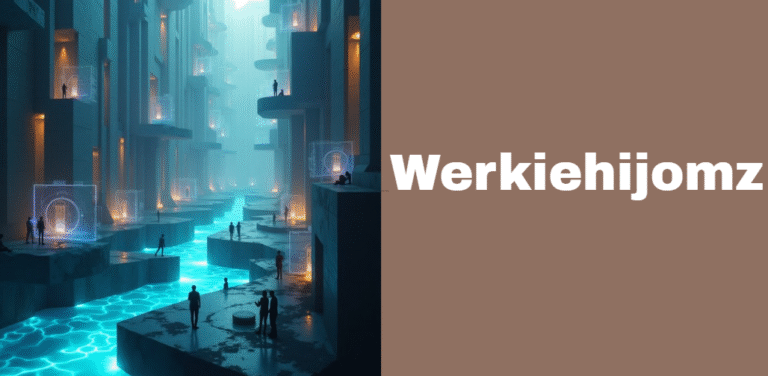Zoswerheoi Explained: A Comprehensive and Easy Writing Guide with a Detailed Outline
In the evolving world of innovation frameworks, one concept gaining traction is zoswerheoi. It’s not just a trendy term but an emerging approach that offers a smart, flexible, and human-centered pathway to achieving success in complex systems. Whether you are involved in tech startups, educational innovation, or decentralized governance models, understanding zoswerheoi can be a game-changer.
The idea behind zoswerheoi goes beyond traditional workflows. It integrates agility, user-centered design, AI-powered adaptability, and systems thinking to create a dynamic ecosystem where decision-making and creativity flourish.
In simpler terms, zoswerheoi helps teams move smarter and faster, while staying aligned with the people they serve. This content will explore every aspect of the topic, making sure it stays true to the request to please describe the informative easy writing long & detailed content outline table of content about “zoswerheoi” in an organic and meaningful way.
Origins and Conceptual Foundations
The term zoswerheoi is a blend of emerging digital philosophies, drawing from agile development, decentralized architecture, and collaborative leadership models. It appeared as a response to the growing need for systems that are more human-focused, less bureaucratic, and far more adaptive.
At its core, zoswerheoi was shaped by shifts in global thinking — the move toward remote work, the rise of decentralized technologies like blockchain, and the pressing need for ethical AI. Together, these forces influenced how the zoswerheoi mindset came to life, offering a blueprint for transparent, responsive, and scalable innovation.
Core Principles of the Zoswerheoi Framework
Understanding zoswerheoi means grasping the principles it stands on. These core concepts guide how individuals and teams behave in a zoswerheoi-driven environment. It’s not just about tools — it’s about how we think and act.
The following table outlines the key values that make up the zoswerheoi approach:
| Principle | Description |
|---|---|
| Decentralization | Decision-making is distributed, giving each node or team autonomy. |
| Transparency | Open communication ensures all actions and results are visible. |
| Human-Centered Design | People are at the core — solutions must serve their needs. |
| Adaptive Intelligence | AI systems assist decisions by learning from real-time data. |
| Iterative Thinking | Projects evolve in small, tested steps rather than grand launches. |
Together, these principles help organizations work smarter and more ethically, while staying flexible and efficient.
How Zoswerheoi Works in Practice
Implementing zoswerheoi involves understanding its functional layout — it’s designed like a living network. Each part of a team or system acts as a node, communicating and operating semi-independently but always aligned to a common purpose.
The process begins with mapping the ecosystem — understanding what elements (people, tools, data streams) interact and how. From there, zoswerheoi encourages microservices architecture, real-time feedback systems, and small-scale testing. AI-powered data layers help detect patterns, allowing the system to adapt itself continuously.
In this model, innovation doesn’t happen in isolated departments. Instead, it happens across the system — simultaneously, collaboratively, and transparently.
User-Centered Design and Agile Thinking
One of the most empowering aspects of zoswerheoi is how it brings user-centered design into harmony with agile workflows. It values deep listening — not just gathering feedback, but integrating it quickly into iterative processes.
For example, product teams using zoswerheoi might run weekly feedback loops, co-create with users, and adjust the next sprint based on actual user reactions. Designers and developers work closely with users at every stage, ensuring the end product reflects real needs, not assumptions.
This balance between flexibility and focus is what makes zoswerheoi so effective.
Systems Thinking Lens
Another defining feature of zoswerheoi is its embrace of systems thinking. Instead of solving individual problems in isolation, zoswerheoi helps teams visualize the whole system. This holistic view allows participants to trace how changes in one area impact others.
For instance, a zoswerheoi-based education platform might explore how curriculum changes affect student engagement, teacher workload, and long-term retention — all in one integrated loop. It supports healthy interdependence, making decisions more thoughtful and outcomes more sustainable.
Applications in Real-World Contexts
Zoswerheoi is not just a theory — it’s already being applied in diverse fields:
- Fintech firms are using zoswerheoi principles to create decentralized financial tools with built-in transparency and trust.
- Educational platforms rely on its feedback-first philosophy to improve learner experience through iterative design.
- Healthcare systems are beginning to test zoswerheoi-inspired collaboration models to better align data, diagnostics, and human-centered care.
- Environmental projects apply it to create self-managed sustainability frameworks that adapt as conditions change.
The key takeaway is that zoswerheoi is flexible enough to adapt to any industry where complexity and human impact intersect.
Advantages of Zoswerheoi
Adopting zoswerheoi can bring a variety of benefits to both individuals and organizations. These advantages make it a compelling alternative to traditional, rigid management systems:
- Encourages faster, smarter decision-making through distributed control.
- Fosters creativity and ownership by empowering all participants.
- Reduces friction and bottlenecks by automating repetitive tasks.
- Builds trust with users and stakeholders by being transparent.
- Improves product quality through continuous user engagement and testing.
These benefits are especially vital in fast-paced industries, where adaptability and transparency are the keys to staying competitive.
Challenges to Consider
Despite its strengths, zoswerheoi is not without challenges. The very flexibility that gives it power can also create confusion if not managed well. Teams may struggle with:
- Onboarding users into a decentralized system.
- Creating clear protocols in a system without rigid top-down structure.
- Balancing automation with the need for ethical, human decisions.
- Avoiding overload from continuous feedback cycles.
However, these challenges are manageable with the right planning, tools, and mindset.
Steps for Implementation
Bringing zoswerheoi into action doesn’t require massive disruption. In fact, it thrives on gradual, layered changes. Here’s a phased roadmap you can use:
| Stage | Key Actions |
|---|---|
| Awareness | Identify current bottlenecks and outdated workflows. |
| Engagement | Create multidisciplinary teams and involve end users early. |
| Prototyping | Start with small-scale pilots to test zoswerheoi workflows. |
| Reflection | Use data to evaluate what works and what doesn’t. |
| Expansion | Gradually roll out successful models across the wider system. |
Each phase builds on learning, keeping risk low and results high.
Real-World Case Examples
Several early adopters have embraced zoswerheoi to great success:
- A design startup restructured its entire team around zoswerheoi and reduced product launch time by 40%.
- A nonprofit applied its principles to global water access programs, improving coordination and transparency across remote teams.
- A university integrated zoswerheoi thinking into curriculum design, enabling real-time updates to course content based on student feedback.
These examples show zoswerheoi’s adaptability and its power to reshape how people collaborate and innovate.
Future Potential of Zoswerheoi
Looking ahead, zoswerheoi is poised to redefine how organizations operate. It blends the best of agile, human-centered, and AI-supported thinking into a scalable model that could influence:
- Governmental decision-making structures.
- Smart city infrastructures.
- Ethical AI development.
- Global education systems.
As digital ecosystems continue to grow, zoswerheoi offers a framework that evolves with them — not against them.
Conclusion
Zoswerheoi is more than a framework — it’s a mindset and methodology that aligns with the needs of today and the possibilities of tomorrow.
If you’re someone who seeks flexible, transparent, and sustainable innovation, adopting zoswerheoi may be one of the smartest moves you can make.
Additional Posts
Understanding Qiowofvuhoz: The Mysterious Term with Multilayered Meaning in Tech, Life & Data
Understanding Namiszovid: Meaning, Uses, and Online Mystery Explained
Is Qowiszojid54 Waterproof? A Full Breakdown of Its Water Resistance Capabilities
Is Waxillgro279 Safe to Use? Full Guide to Its Applications, Safety, and Risks






